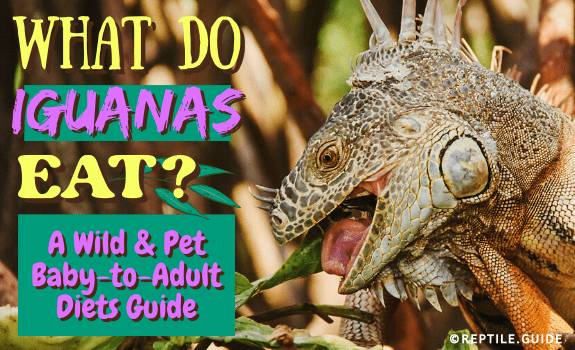Unlike many lizards, iguanas are obligate herbivores. This means that they MUST eat vegetable matter to survive.
We’ll now take a closer look at other factors that affect the iguana’s diet, both in the wild and in captivity. Let’s answer in detail: “What do iguanas eat”?
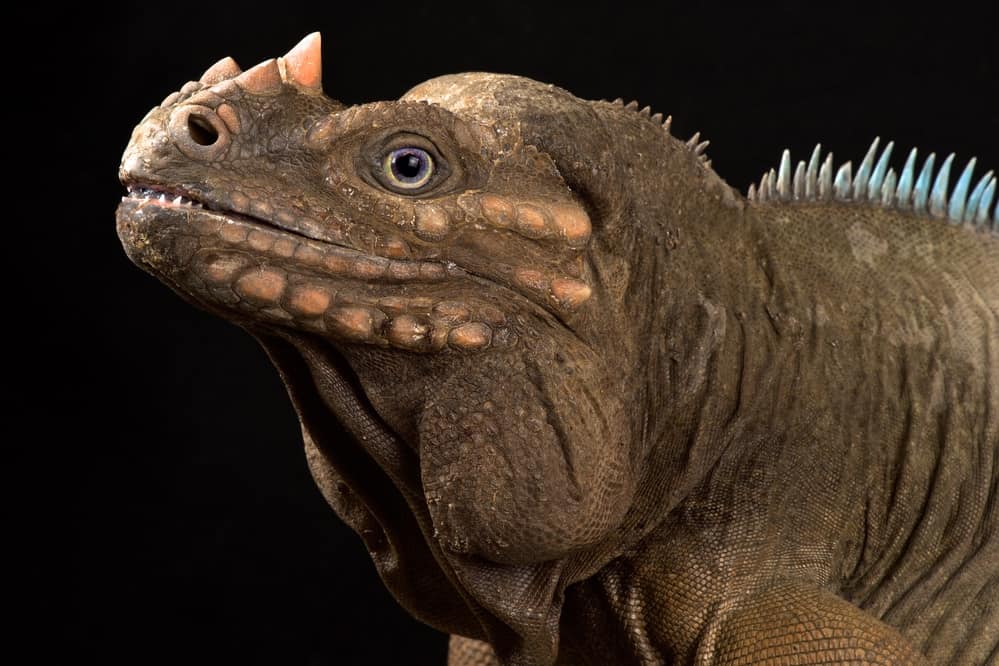
In This Article
What Do Iguanas Eat in the Wild?
In the wild, the iguana’s diet consists of the leaves and flowers of trees and other plants.
Wild iguanas may eat small animals and insects, but this is an unusual occurrence.
What Do Green Iguanas Eat in Florida?
Green iguanas in Florida eat a variety of native, ornamental, and cultivated plants.
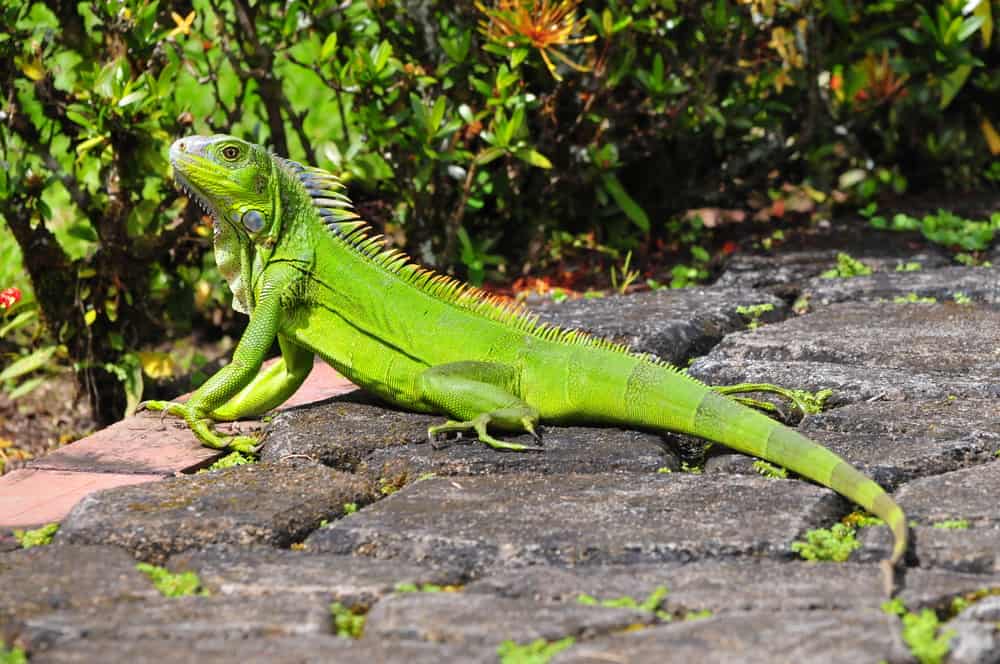
Some of the preferred food plants of the green iguana in this foreign landscape include:
- Orchids
- Jasmine
- Hibiscus
- Firebush
- Nickerbeans
- Leafy greens
- Rose bushes
- Squashes and Melons
- Washington Fan Palms
The common green iguana is an introduced species in South Florida.
Green iguanas’ habit of eating the foliage and flowers of ornamental plants and those grown for food make them serious pests in this area.
The green iguana is an opportunist and happily eats even the first tender young shoots after winter, which can kill the plants.
Scientists have also found that the green iguana is displacing native species in this area.
What Do Iguanas Eat in Aruba?
The green iguanas of Aruba, known as Yuwana, eat the leaves and fruits of native plant species.
In turn, the iguana is a local delicacy.
Fun Fact: Despite the restriction on killing these iguanas, Aruban locals still face the wrath of the law to catch iguanas and make a traditional iguana soup.
What Do Iguanas Eat in Mexico?
Mexican iguanas, like almost every iguana species, eat flowers, leaves, and fruits. They may also eat insects, eggs, and small animals.
Two different species of iguana live in Mexico.
The spiny-tailed iguana has a range covering most of Mexico. It feeds on the leaves, flowers, and vegetables of local plants.
This species is an opportunist and may consume any small animals, lizards, or eggs that it can find.
Since this iguana’s diet includes salty plants, it’s developed a sac on its snout where it can store excess salt.
The desert iguana’s range covers the northwestern part of Mexico.
This species lives in creosote bushes, where it eats the leaves and flowers of the plant. It also includes other desert plants in its diet.
Other foods for this iguana include insects and the fecal droppings of other animals.
What Do Iguanas Eat in Puerto Rico?
Puerto Rican iguanas eat the leaves, flowers, and fruits of native plant species.
The green iguana is common in Central and South America, and its diet consists almost solely of the leaves and flowers of trees and vines.
Fruit is a less common food for these reptiles, though they sometimes feed on smaller lizards and other animals.
What Do Iguanas Eat in the Rainforest?
Rainforest iguanas feed on the leaves, flowers, and fruit produced by the trees and vines.
The common green iguana is the most common resident of the rainforest.
The same opportunism that has made it so successful in foreign environments (like Florida) helps keep it alive at home.
While these animals prefer feeding on foliage, they may accept other food that comes their way.
The green iguana is an opportunistic herbivore that eats plants but may supplement its diet with small animals.
What Do Iguanas Eat in the Desert?
Desert iguanas survive by eating the flowers and leaves of desert plants, as well as fecal pellets and insects.
The main retreats of desert iguanas include creosote bushes and hollowed-out parts of large cacti.
This species eats the droppings of other desert animals.
Because desert plants have such tough, fibrous foliage, these iguanas require a specific type of gut bacteria to digest them.
Eating droppings help the iguanas to keep their gut bacteria balanced and functioning.
What Does a Pet Iguana Eat?
A pet iguana’s diet is similar to that of a wild iguana, and the main part consists of leafy greens.
In most parts of the world, leaf vegetables are a small part of a human meal, rather than the main part of it. This results in a lack of available variety.
Finding ways to offer captive iguanas a varied and blanched diet is essential.
Iguana owners can feed these fruits and vegetables to their iguana:
- Green Beans
- Bell Peppers
- Radish and Turnip Greens
- Dandelion Greens and Flowers
- Mustard Greens
- Collard Greens
- Butternut or Spaghetti Squash
- Rocket or Arugula Leaves
- Endive, Radicchio, or Chicory Leaves
- Hibiscus Leaves or Flowers
- Nasturtiums
- Prickly Pear Cactus (Pads or Fruits)
As you can see, iguanas need a diet that only includes fruits now and then. Vegetables should make up the main component.
You can give your iguana prepared iguana food to help supplement the nutrients in their daily diet.
Iguanas as a group are opportunists. They feed on plants but may eat other animals.
Calcium Intake
Like most reptile species, iguanas need an appropriate amount of calcium in their diets to stay healthy.
Low calcium levels can lead to metabolic bone disease and other similar problems.
Add a high-quality calcium powder to your iguana’s food to ensure that they get enough calcium.
The wrong calcium to phosphorus ratio can contribute to metabolic bone disease.
Phosphorus binds to calcium in the bloodstream, preventing calcium absorption into the iguana’s body.
It’s essential to check the ratio of phosphorus to calcium in any food that you give your iguana.
Feed more foods that have high calcium to low phosphorus ratio. Give foods that have a high phosphorus content only occasionally.
Juvenile iguanas, in particular, need a large amount of calcium in their diet.
Oxalic Foods
The oxalates are a group of acids that, like phosphorus, bind to calcium and prevent calcium absorption.
Do careful research before feeding your iguana. Don’t give them oxalic foods more than two times a month.
To an animal with a high calcium requirement, overfeeding foods that bind to calcium can be fatal.
What Do Baby Iguanas Eat?
A baby iguana eats the same foods as adults but in smaller amounts. Their diet should consist of 95% leaf veg, and 5% fruits and other vegetables.
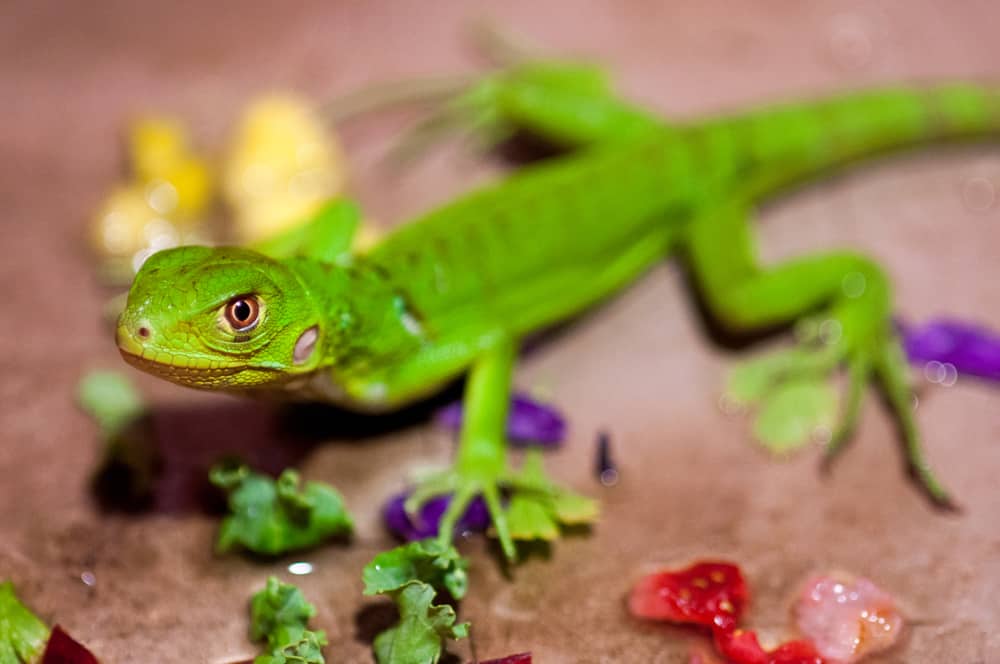
Some of the best food sources for a baby iguana include:
- Chopped fresh alfalfa
- Grated courgettes and squashes
- High-calcium green like collards
- Blooms from pesticide-free roses, hibiscus, and squash
Baby iguanas eat a similar diet to adults but in smaller portions.
What Vegetables Do Iguanas Eat?
Leafy, green vegetables and herbs are the best choice for your pet. Options include:
- Collard greens
- Turnip and radish greens
- Sage, rosemary, and oregano
- Lambs lettuce
- Watercress
- Pak choi
- Basil and mint
There’s a fair amount of vegetable feeding options for your pet iguana.
Some of them may have negative effects if fed daily. Consider the nutrition value of the vegetable before feeding.
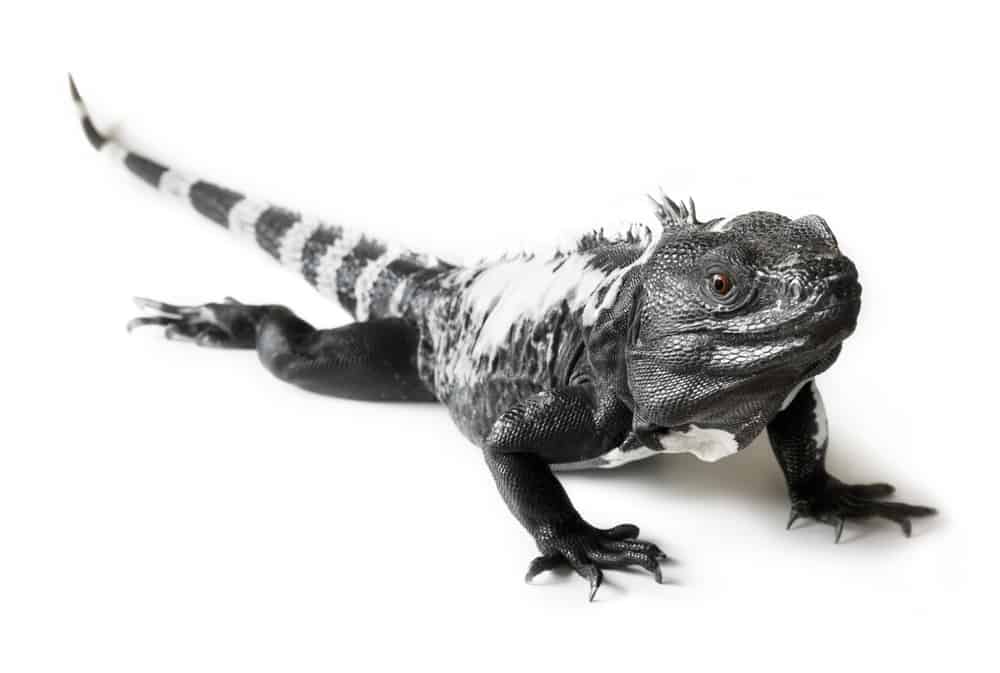
The word vegetable means a part of a plant that you can eat.
Taken in that light, you can feed your pet various weeds and plants, like:
- Clover
- Alfalfa
- Mallow
- Ribwort
- Plantain
- Hedge mustard
- Dandelion greens
These reptiles love floral snacks, and you can feed them blooms from:
- Roses
- Pansies
- Lavender
- Apple trees
- Dandelions
- Nasturtiums
- Snapdragons
- Squash
- Hibiscus
Can Iguanas Eat Broccoli?
Your pet iguana CAN consume broccoli, but only now and then.
Broccoli shouldn’t be part of your pet’s main diet. However, you can use it as a treat, and it provides some nutritional benefits.
Broccoli is the unopened bud of the broccoli plant, so it’s a type of bloom.
This plant family contains chemicals that bind to iodine and prevent the iguana from absorbing it.
Feeding too much broccoli to your iguana can cause thyroid issues or other health issues.
Can Iguanas Eat Cabbage?
Your pet iguana CAN consume cabbage, but only on occasion.
You should feed any members of the cabbage family sparingly as they bind iodine.
Iodine is essential for proper thyroid function, so you don’t want to feed your pet too many of these veggies.
A good diet should only incorporate brassicas (a kind of cabbage) one or two times a month.
Vegetables That You Should Only Feed to Your Iguana Rarely
As we mentioned above, cabbage binds iodine and shouldn’t feature in your iguana’s diet often.
Other plants in the cabbage family that you should feed only once in a while include:
- Kales
- Turnips
- Broccoli
- Pak choi
- Bok choi
- Radishes
- Mustard greens
- Brussel sprouts
- Rutabagas and kohlrabi
Other vegetables that bind either iodine or calcium or lack nutritional value include:
- Yam
- Okra
- Carrots
- Beetroot
- Courgettes
- Lima beans
- Cucumbers
- Wheatgrass
- Kidney beans
Most of these vegetables can play a valuable role in the overall diet of your iguana.
However, you should balance the diet by providing a mix of fruits and vegetables, using calcium powder, and not overfeeding a single type of vegetable.
A prepared iguana food can also help supplement the nutritional needs of your pet.
We suggest keeping a journal to help track your iguana’s diet.
What Fruits Do Iguanas Eat?
Iguanas can eat various fruits in captivity, though they shouldn’t make up the bulk of their diet.
Good options include:
- Figs
- Pears
- Dates
- Apples
- Melons
- Grapes
- Starfruit
- Apricots
- Peaches
- Mangoes
- Tomatoes
- Kiwi Fruit
- Blueberries
- Raspberries
- Strawberries
- Skin-on Bananas
Can Iguanas Eat Apples?
Iguanas CAN eat apples, but they should only make up a small percentage of their diet.
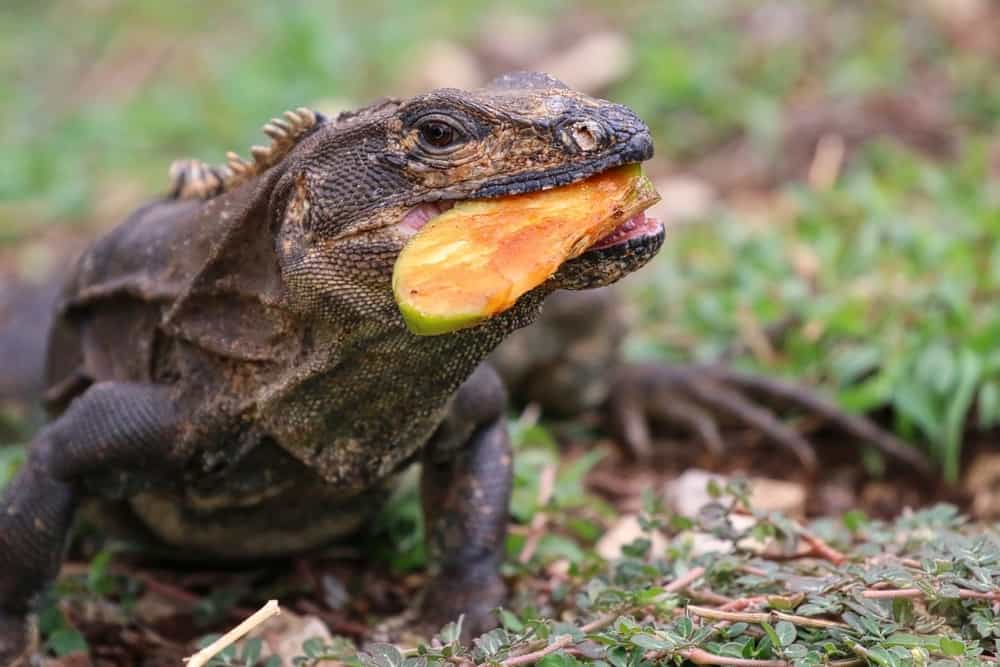
Apples contain a lot of sugar.
These lizards can handle more sugar than some other species. This is because they eat the fruit in the wild. However, the healthy option is to provide limited amounts of sugar.
Fruit as a whole shouldn’t make up more than around ten percent of your iguana’s diet.
You can give your iguana (adult) around one-half of an apple every month.
How Do Iguanas Eat?
Iguanas swallow their food whole.
In the wild, these reptiles tend to grab food items that are small enough to swallow.
Failing that, they tear off chunks of food that they swallow whole.
By chopping or grating your pet’s food, you can make it easier for them to eat it.
You need to shred harder vegetables like squash so that the lizard can swallow them.
Softer foods like greens and apples are easy to consume once you’ve chopped them.
If your iguana eats a large chunk of food, it can cause several problems. These include:
- Choking
- Impaction
- Constipation
It’s vital to ensure that your green iguanas have manageable food sizes.
Green Iguana Diet vs. Spiny-Tailed Iguana Diet
Green iguanas and spiny-tailed iguanas have similar diets, both in captivity and in the wild.
Spiny-tailed iguanas come from drier habitats. Green iguanas prefer wet habitats.
These iguanas eat a lot of foliage, flowers, and some fruits.
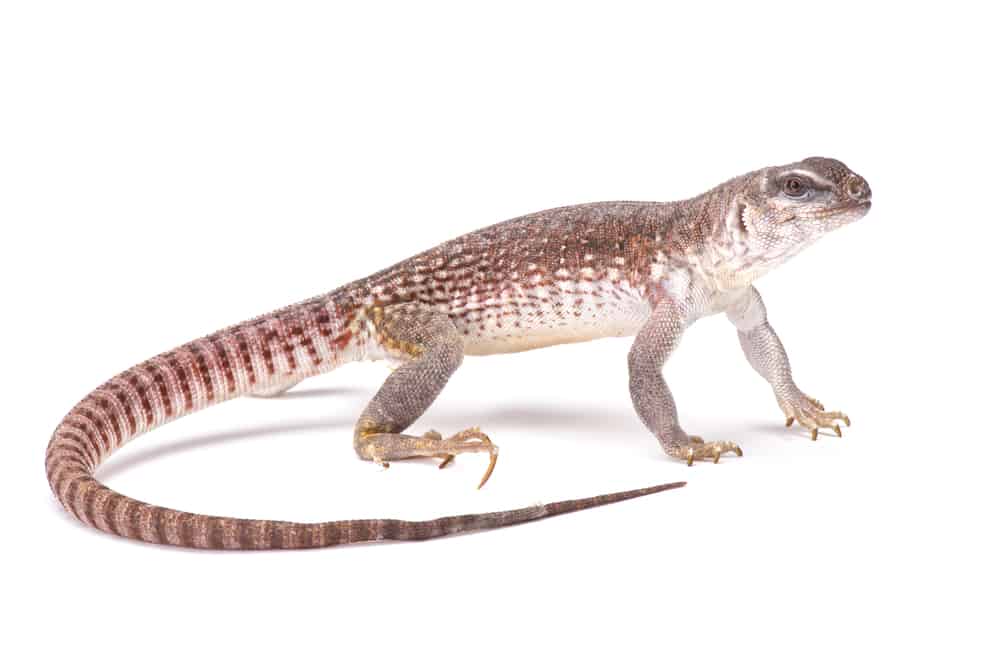
The main difference is that their habitats don’t contain the same plant species.
Most iguanas eat a similar diet. The same basic rules apply to desert, spiny-tailed, green, or rhino iguanas.
True iguanas all tend to be herbivores. They eat vegetables but may eat other animals if they get the chance.
Some iguana types may be more inclined to snack on insects than others. The healthy option is not to feed your pet insects or animals.
We hope you’ve enjoyed this article about iguana diets.
If you have, be sure to check out some of our other iguana-related articles. Our bearded dragon vs. iguana comparison, for example.
In addition to a proper diet, iguanas require a proper cage setup to be healthy.
You may also like our article about the most intelligent reptiles.
Alternatively, you can find out what other fascinating animals are eating.
For example, find out about what axolotls eat in the wild and in captivity.
Do you have a pet iguana, are you planning on getting one, or were you simply curious about iguana diets? Let us know in the comments.
